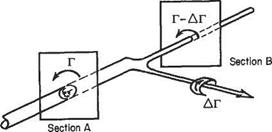Helmholtz’s theorems
The four fundamental theorems of vortex motion in an inviscid flow are named after their author, Helmholtz. The first theorem has been discussed in part in Sections 2.7 and 4.1, and refers to a fluid particle in general motion possessing all or some of the following: linear velocity, vorticity, and distortion. The second theorem demonstrates the constancy of strength of a vortex along its length. This is sometimes referred to as the equation of vortex continuity. It is not difficult to prove that the strength of a vortex cannot grow or diminish along its axis or length. The strength of a vortex is the magnitude of the circulation around it and this is equal to the product of the vorticity Є and area S. Thus
T = CS
It follows from the second theorem that (S is constant along the vortex tube (or filament), so that if the section area diminishes, the vorticity increases and vice versa. Since infinite vorticity is unacceptable the cross-sectional area S cannot diminish to zero.
In other words a vortex line cannot end in the fluid. In practice the vortex line must form a closed loop, or originate (or terminate) in a discontinuity in the fluid such as a solid body or a surface of separation. A refinement of this is that a vortex tube cannot change in strength between two sections unless vortex filaments of equivalent strength join or leave the vortex tube (Fig. 5.6). This is of great importance in the vortex theory of lift.
The third and fourth theorems demonstrate respectively that a vortex tube consists of the same particles of fluid, i. e. there is no fluid interchange between tube and surrounding fluid, and the strength of a vortex remains constant as the vortex moves through the fluid.
The theorem of most consequence to the present chapter is theorem two, although the third and fourth are tacitly accepted as the development proceeds.
|
|
Fig. 5.6












